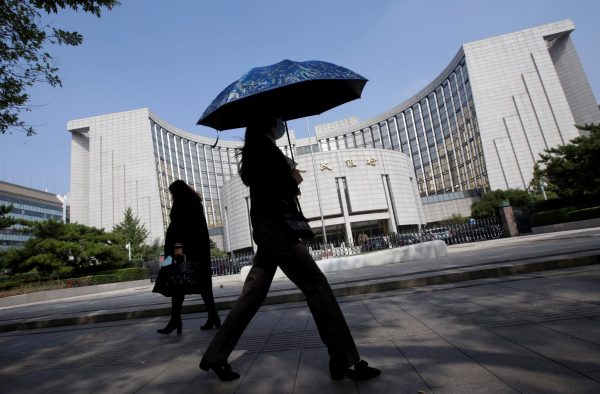Chinese authorities have intensified their focus on financial risks over the past two years. Chinese President Xi Jinping demonstrated high-level support when he took the unusual step of chairing the National Financial Work Conference himself last July. Regulators have also found themselves able to better coordinate to manage regulatory blind spots and arbitrage thanks to the updated structure of financial regulation.
Shadow banking from institutions supervised by empowered central regulators is shrinking. One of the best ways to measure shadow credit funded by banks is through their lending to non-bank financial institutions. It rose 80 per cent year-on-year in February 2016, but over the last year has shrunk by 4 per cent.
Central bank credit measures also suggest that core shadow banking channels (trust loans, entrusted loans and undiscounted bankers’ acceptances) have been shrinking for most of 2018. Plain renminbi loans from banks make up an increasing share of new credit. Though shadow finance tends to find ways around new rules, these figures suggest hard-won regulatory progress.
But P2P continued to boom while other shadow finance channels contracted. Authorities were aware of the risks since at least mid-2013 when the sector’s lending was less than one-tenth of what it is today. Central bank inspections discovered then that platforms were acting as underground banks and were at risk of bank-style runs, but no regulator wanted to take the responsibility that would come with trying to clean up the mess.
China’s cabinet later put the China Banking and Regulatory Commission (now the CBIRC) in charge of online lending policy, which declared that P2P platforms would be ‘information intermediaries’ that facilitate lending between individuals — not financial intermediaries handling funds directly. Still, implementation and vital data are left fragmented in the hands of local governments. Authorities wary of precipitating failures by regulating too harshly have continually extended deadlines for compliance, most recently in June 2018.
The dilemma is familiar for Chinese regulators: gradual measures that keep credit taps open versus a crackdown that reduces long-run risk at the cost of failed investments and investor wrath upon ‘overzealous’ regulators. The number of surviving P2P platforms has been on a gradual decline since November 2015, but regulators were caught off guard when failures suddenly accelerated in mid-June 2018. Investors began to panic and tried to pull their money out, sparking yet more failures. Many protested for government help when they found that their savings had been stolen or sunk into bad loans.
Outstanding loans then plummeted by 300 billion RMB (US$44 billion), from 1.3 trillion RMB (US$190 billion) to just under 1 trillion RMB (US$146 billion). They fell again in August, but the outflows and failures moderated. The storm may have passed, leaving most platforms intact for now.
Regulators announced ten measures in response to these risks on 12 August. Unfortunately, they continue to use the same approach that has failed to curb risky practices like flimsy guarantees, frauds and maturity transformation. Unintended consequences will also result and a new category of victims will be created if authorities use the social credit system to automate punishment of P2P loan defaulters. Chinese people who never actually borrowed money could be surprised to find themselves on blacklists if identity-theft helped criminals borrow in their name, or if platforms falsify records that list them as borrowers.
Now that authorities have slowed the panic, they should establish a licensing regime with mandatory, real-time data reporting that allows regulators to track the overall risk and where it is concentrated. The National Internet Finance Association and local governments announced a ‘self-check’ starting 22 August, in which platforms are required to report statistics like outstanding and non-performing loans.
But this unintentionally seems to reveal that regulators are in the dark on 1 trillion RMB (US$146 billion) in loans. Even this figure may be understated, because it is well known in the industry that larger platforms only report a small share of their loans to data providers to avoid attracting regulatory scrutiny.
The new CBIRC organisational plan announced on 23 August strengthens a unit focussed on illegal fundraising common in P2P, but much more remains to be done. Online lenders will face less risk and fraud once Baihang, the new quasi-governmental credit evaluation and data sharing system, is working. But most importantly, just as they are trying to do with wealth management products, the perception that P2P investments are ‘guaranteed’ must be broken.
A well-regulated P2P sector can still fill an important niche in China’s economy by satisfying small businesses’ demand for credit and catering to enormous investor demand for speculative products with high yields. But it needs to be clear that investors do so at their own risk.
Martin Chorzempa is a research fellow at Peterson Institute for International Economics.

